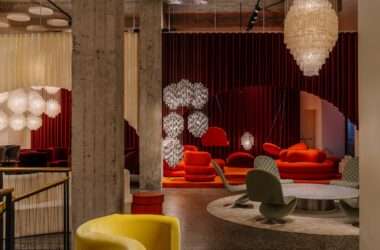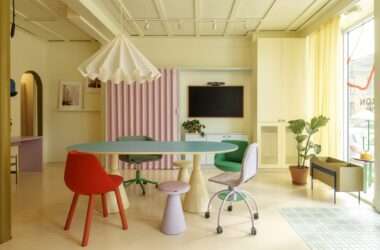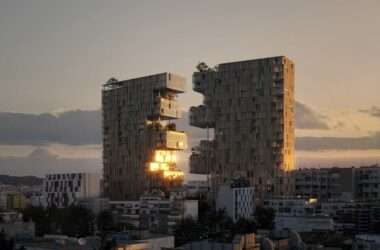Header: Olympiastadion, in UEFA.com
Euro 2024 has arrived, and people across Europe can’t help but feel butterflies in their belly. With the return of warm weather and a resurge in tourism, Europeans are coming together to share cultures, food, and a love for championship football. As we gather to cheer our favorite teams on, it’s easy to forget that these thrilling matches are hosted in massive stadiums capable of accommodating thousands of fans.
This year’s Euro Cup is held in Germany, a country renowned for its impressive stadiums and arenas. In this article, D5 will delve into some of these venues. These arenas will be home to countless moments filled with conundrums, happiness, sadness, screams, and prayers. While these moments are captivating, we are particularly interested in the walls that will hold these great experiences inside.
Olympiastadion, Berlin

The final of the Euro 2024 is scheduled for July 14th and is going to be held at the Olympiastadion in Berlin, a stadium that was originally designed by Werner March for the 1936 Summer Olympics. This enormous neoclassical stadium was dressed in limestone, travertine, and granite stones to showcase the might of Nazi Germany to the rest of the world. Therefore, as grandeur was the goal, the Olympiastadion was designed with attention to detail, having some over-the-top elements, such as the Marathon Gate, that make it one of a kind.
In more recent years, this goal was upheld as Berlin started renovating the stadium and adding a vast, translucent oval roof covering all seats, designed by Gerkan, Marg & Partners from 2000 to 2004. This roof, made from PTFE-coated glass fiber, not only makes the stadium a wonder to look at but also enhances its comfortability, which is necessary in a place able to welcome up to 74,475 people. In the renovation, the stadium also welcomed modern seating, advanced lighting, and better sound systems. The lighting system, for example, features full-color floodlighting with innovative reflector technology, which significantly improved the stadium’s energy efficiency while also providing vibrant illumination for night events.
Allianz Arena, Munich

The Allianz Arena was the stadium chosen to hold the first match of the Euro Cup, a game between Germany and Scotland. Located in Munich, the stadium was designed by the acclaimed architectural firm Herzog & de Meuron and is one of the most recognizable stadiums in the world. Completed in 2005, the arena is home to Bayern Munich and is celebrated for its futuristic design, which gave fans an impressive facade.
The stadium’s exterior is made of ETFE plastic panels that can be illuminated in various colors, making Bayern or German fans ecstatic anytime an important game is held. With a seating capacity of around 66,000, the Allianz Arena gives fans their money’s worth by not only giving them a great football match but also keeping them comfortable and entertained with its lighting and video technologies. The stadium’s equally impressive interior is spacious and modern, holding everything players, officials, and fans can ever need.
Signal Iduna Park, Dortmund

Host of one of the semi-final games, Signal Iduna Park, also known as the Westfalenstadion, is home to Borussia Dortmund and is the team’s electrifying yellow atmosphere—a quick reference to the stadium’s “Yellow Wall” terrace, the largest standing terrace in European football. Designed by Architekturbüro Planungsring, the stadium was built in 1974 and has been continuously renovated throughout the years due to its growing popularity.
The structure was created through a blend of concrete and steel and features a modular design that allows for future expansions and alterations. Its interesting shape, rectangular with four prominent corner towers, makes it quite a popular stadium among football fans, perhaps because such a castle-y look makes matches seem more magical than they already are. This fortress design is, however, not just visually interesting; it also enhances the stadium’s acoustics, amplifying the noise and creating an intimidating atmosphere for visiting teams. Currently, 81,365 fans can comfortably enjoy a domestic match. However, the stadium’s capacity is reduced to 62,000 for international events, perhaps to lower the chances of conflict among nations.
Volksparkstadion, Hamburg

The future home for several group stage matches and one quarter-final game, the Volksparkstadion was designed by Ernst Sagebielhaving and extensively renovated in 2000 by Hilmer & Sattler und Albrecht. The stadium has been hosting sports events since 1953, and its growing popularity led Hamburg, the city where it stands, to modernize it several times. With a new roof made of a light and durable material that allows it to cover all seats and enhance the acoustics, updated seating, and more, this stadium is now a comfortable venue for 49,000 football enthusiasts.
Arena AufSchalke, Gelsenkirchen

The Arena AufSchalke will host several group stage games and Round of 16 matches, the Spain versus Italy one being the most anticipated of them all. Also known as the Veltins-Arena for sponsorship reasons, this stadium was designed by Hentrich, Petschnigg & Partner (HPP) and opened in 2001. The stadium can accommodate up to 50,000 spectators and is known for its excellent facilities and the immersive experience it offers. Known for its innovative features, such as a retractable roof and slide-out pitch, plus the latest sound and lighting systems, the structure combines steel and glass to give it a modern and sophisticated look.










